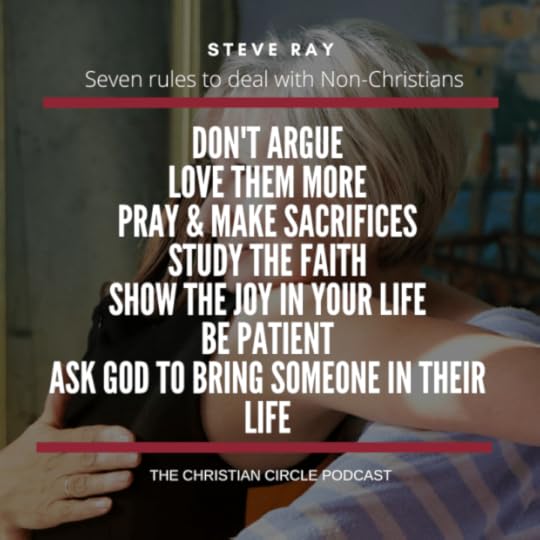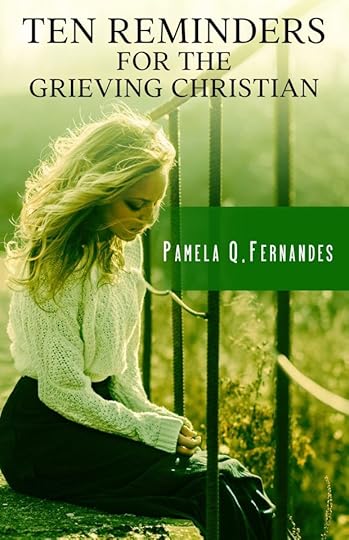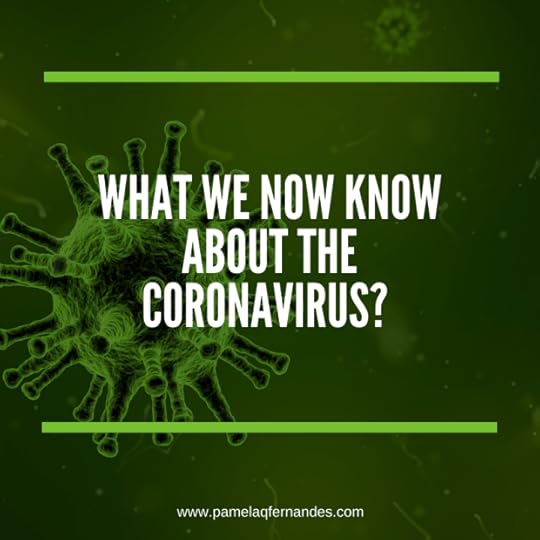Pamela Q. Fernandes's Blog, page 13
June 30, 2020
64 How To Stop Gossiping?
“Gossip destroys people. If you have a problem with someone, go directly to that person.”
Ann DeSantis

WHO IS ANN DESANTIS?
 Anne DeSantis
Anne DeSantisAnne DeSantis is a wife and a “Mom” and the director of a non-profit called the St. Raymond Nonnatus Foundation for Freedom, Family, and Faith. Additionally, Anne is a Catholic Author with CatholicMom, Catholic 365, and Catholic Lane. She hosts a weekly podcast with co-host Bill Snyder called “Sewing Hope.” She also hosts a weekly online TV show called “Journeys in Faith with Anne DeSantis” on Fiat Ministry Network. More information can be found about Anne DeSantis at www.annedesantis.com. The website for the St. Raymond Nonnatus Foundation is www.nonnatus.org.
PQF · 64 How To Stop Gossiping?
In this episode, Pamela Q. Fernandes talks to Ann DeSantis about gossiping. She talks about:
-Why is gossip a problem?
-How does being humble help?
-What are some rules to stop gossip?
-What do we do when we’ve participated and now realize our mistake?
How you can stop gossiping?
I saw this post on gossip by Anne on Catholicstand. In it, she talked about why and how gossip is so destructive. She also laid out some rules as to how we can weed out this sin from our lives. Ann shares her experiences after having dealth with this issue. The rules are the fruit of her own personal encounters.
She explains a few rules about dealing with gossip. I encourage you to listen and see what helps you best. One of her best tips is to simply walk away.
Easier said than done. Gossip is a thin line. You’re talking and then suddenly spilling. I guess her tip, ‘talk less, listen more’ is poignant.
ENJOYED THIS PODCAST?
We hope you enjoyed this podcast. Check out our podcasts on Mother Teresa and Making Time for Prayer.If you liked this podcast, like us, leave us a comment and share our episodes on social media with those who may benefit from it. If there is a particular saint that you would like to hear about us, tell us and we’ll add him or her to our future episodes.
We are on iheartradio, Stitcher, Itunes, and tunein.com. We’d love to hear from you. If you hear us on Itunes, please rate and review us.
The post 64 How To Stop Gossiping? appeared first on PAMELA Q. FERNANDES.
June 7, 2020
Summer Beach Reads Contest

Summer is here and so is our Summer Beach Reads Contest. I’m giving away two print copies from this list along with my own. I’m also giving away e-copies of books by author Mark Love, Lori Sizemore, Phyllis Cherry, and Kari O’Sullivan.
Summer Beach Reads Contest
For those who want to find out more, here’s the list of all these books. The general blurb and links are added. That’s my complete list for summer reads. I’ve read most if not all and will get around to reading them all this summer.
This sweepstakes is open to residents of the United States (excluding Puerto Rico and all other US territories). Entries will be accepted until 11:45 pm, July 31. To sign up for the summer beach reads contest, you can enter below.
Summer 2020 Contest
Bonus Prize
Everyone wants free stuff! And I’ve got more. Alternatively, you can get an additional print copy of one of these books if you sign up to my newsletter! That’s a bonus prize! Do you feel lucky?
Not only that, for the bonus prize, I’m adding Bowled to the giveaway bag!
I only send the newsletters once a month and they’re super short. So sign up!
@import url(https://fonts.googleapis.com/css?fami...
/* LOADER */
.ml-form-embedSubmitLoad {
display: inline-block;
width: 20px;
height: 20px;
}
.ml-form-embedSubmitLoad:after {
content: " ";
display: block;
width: 11px;
height: 11px;
margin: 1px;
border-radius: 50%;
border: 4px solid #fff;
border-color: #ffffff #ffffff #ffffff transparent;
animation: ml-form-embedSubmitLoad 1.2s linear infinite;
}
@keyframes ml-form-embedSubmitLoad {
0% {
transform: rotate(0deg);
}
100% {
transform: rotate(360deg);
}
}
#mlb2-954334.ml-form-embedContainer {
box-sizing: border-box;
display: table;
height: 99.99%;
margin: 0 auto;
position: static;
width: 100% !important;
}
#mlb2-954334.ml-form-embedContainer h4,
#mlb2-954334.ml-form-embedContainer p,
#mlb2-954334.ml-form-embedContainer span,
#mlb2-954334.ml-form-embedContainer button {
text-transform: none !important;
letter-spacing: normal !important;
}
#mlb2-954334.ml-form-embedContainer .ml-form-embedWrapper {
background-color: #ffffff;
border-width: 0px;
border-color: transparent;
border-radius: 4px;
border-style: solid;
box-sizing: border-box;
display: inline-block !important;
margin: 0;
padding: 0;
position: relative;
}
#mlb2-954334.ml-form-embedContainer .ml-form-embedWrapper.embedPopup,
#mlb2-954334.ml-form-embedContainer .ml-form-embedWrapper.embedDefault { width: 400px; }
#mlb2-954334.ml-form-embedContainer .ml-form-embedWrapper.embedForm { max-width: 400px; width: 100%; }
#mlb2-954334.ml-form-embedContainer .ml-form-align-left { text-align: left; }
#mlb2-954334.ml-form-embedContainer .ml-form-align-center { text-align: center; }
#mlb2-954334.ml-form-embedContainer .ml-form-align-default { display: table-cell !important; vertical-align: middle !important; text-align: center !important; }
#mlb2-954334.ml-form-embedContainer .ml-form-align-right { text-align: right; }
#mlb2-954334.ml-form-embedContainer .ml-form-embedWrapper .ml-form-embedHeader img {
border-top-left-radius: 4px;
border-top-right-radius: 4px;
height: auto;
margin-top: 0 !important;
margin-bottom: 0 !important;
max-width: 400px!important;
width: 100%;
}
#mlb2-954334.ml-form-embedContainer .ml-form-embedWrapper .ml-form-embedBody,
#mlb2-954334.ml-form-embedContainer .ml-form-embedWrapper .ml-form-successBody {
padding: 20px 20px 0 20px;
}
#mlb2-954334.ml-form-embedContainer .ml-form-embedWrapper .ml-form-embedBody.ml-form-embedBodyHorizontal {
padding-bottom: 0;
}
#mlb2-954334.ml-form-embedContainer .ml-form-embedWrapper .ml-form-embedBody .ml-form-embedContent,
#mlb2-954334.ml-form-embedContainer .ml-form-embedWrapper .ml-form-successBody .ml-form-successContent {
margin: 0 0 20px 0;
}
#mlb2-954334.ml-form-embedContainer .ml-form-embedWrapper .ml-form-embedBody .ml-form-embedContent h4,
#mlb2-954334.ml-form-embedContainer .ml-form-embedWrapper .ml-form-successBody .ml-form-successContent h4 {
color: #d22968;
font-family: 'Palatino Linotype', 'Book Antiqua', Palatino, serif;
font-size: 30px;
font-weight: 700;
margin: 0 0 10px 0;
text-align: center;
word-break: break-word;
}
#mlb2-954334.ml-form-embedContainer .ml-form-embedWrapper .ml-form-embedBody .ml-form-embedContent p,
#mlb2-954334.ml-form-embedContainer .ml-form-embedWrapper .ml-form-successBody .ml-form-successContent p {
color: #d22968;
font-family: Georgia, serif;
font-size: 17px;
font-weight: 400;
line-height: 23px;
margin: 0 0 10px 0;
text-align: center;
}
#mlb2-954334.ml-form-embedContainer .ml-form-embedWrapper .ml-form-embedBody .ml-form-embedContent ul,
#mlb2-954334.ml-form-embedContainer .ml-form-embedWrapper .ml-form-embedBody .ml-form-embedContent ol,
#mlb2-954334.ml-form-embedContainer .ml-form-embedWrapper .ml-form-successBody .ml-form-successContent ul,
#mlb2-954334.ml-form-embedContainer .ml-form-embedWrapper .ml-form-successBody .ml-form-successContent ol {
color: #d22968;
font-family: Georgia, serif;
font-size: 17px;
}
#mlb2-954334.ml-form-embedContainer .ml-form-embedWrapper .ml-form-embedBody .ml-form-embedContent p a,
#mlb2-954334.ml-form-embedContainer .ml-form-embedWrapper .ml-form-successBody .ml-form-successContent p a {
color: #d22968;
text-decoration: underline;
}
#mlb2-954334.ml-form-embedContainer .ml-form-embedWrapper .ml-form-embedBody .ml-form-embedContent p:last-child,
#mlb2-954334.ml-form-embedContainer .ml-form-embedWrapper .ml-form-successBody .ml-form-successContent p:last-child {
margin: 0;
}
#mlb2-954334.ml-form-embedContainer .ml-form-embedWrapper .ml-form-embedBody form {
margin: 0;
width: 100%;
}
#mlb2-954334.ml-form-embedContainer .ml-form-embedWrapper .ml-form-embedBody .ml-form-formContent,
#mlb2-954334.ml-form-embedContainer .ml-form-embedWrapper .ml-form-embedBody .ml-form-checkboxRow {
margin: 0 0 20px 0;
width: 100%;
}
#mlb2-954334.ml-form-embedContainer .ml-form-embedWrapper .ml-form-embedBody .ml-form-formContent.horozintalForm {
margin: 0;
padding: 0 0 20px 0;
}
#mlb2-954334.ml-form-embedContainer .ml-form-embedWrapper .ml-form-embedBody .ml-form-fieldRow {
margin: 0 0 10px 0;
width: 100%;
}
#mlb2-954334.ml-form-embedContainer .ml-form-embedWrapper .ml-form-embedBody .ml-form-fieldRow.ml-last-item {
margin: 0;
}
#mlb2-954334.ml-form-embedContainer .ml-form-embedWrapper .ml-form-embedBody .ml-form-fieldRow.ml-formfieldHorizintal {
margin: 0;
}
#mlb2-954334.ml-form-embedContainer .ml-form-embedWrapper .ml-form-embedBody .ml-form-fieldRow input {
background-color: #ffffff !important;
color: #333333 !important;
border-color: #cccccc !important;
border-radius: 4px !important;
border-style: solid !important;
border-width: 1px !important;
font-size: 14px !important;
height: 40px;
line-height: 20px !important;
margin-bottom: 0;
margin-top: 0;
padding: 10px 10px !important;
width: 100% !important;
box-sizing: border-box !important;
max-width: 100% !important;
}
#mlb2-954334.ml-form-embedContainer .ml-form-embedWrapper .ml-form-embedBody .ml-form-fieldRow input::-webkit-input-placeholder,
#mlb2-954334.ml-form-embedContainer .ml-form-embedWrapper .ml-form-embedBody .ml-form-horizontalRow input::-webkit-input-placeholder { color: #333333; }
#mlb2-954334.ml-form-embedContainer .ml-form-embedWrapper .ml-form-embedBody .ml-form-fieldRow input::-moz-placeholder,
#mlb2-954334.ml-form-embedContainer .ml-form-embedWrapper .ml-form-embedBody .ml-form-horizontalRow input::-moz-placeholder { color: #333333; }
#mlb2-954334.ml-form-embedContainer .ml-form-embedWrapper .ml-form-embedBody .ml-form-fieldRow input:-ms-input-placeholder,
#mlb2-954334.ml-form-embedContainer .ml-form-embedWrapper .ml-form-embedBody .ml-form-horizontalRow input:-ms-input-placeholder { color: #333333; }
#mlb2-954334.ml-form-embedContainer .ml-form-embedWrapper .ml-form-embedBody .ml-form-fieldRow input:-moz-placeholder,
#mlb2-954334.ml-form-embedContainer .ml-form-embedWrapper .ml-form-embedBody .ml-form-horizontalRow input:-moz-placeholder { color: #333333; }
#mlb2-954334.ml-form-embedContainer .ml-form-embedWrapper .ml-form-embedBody .ml-form-horizontalRow {
height: 42px;
}
.ml-form-formContent.horozintalForm .ml-form-horizontalRow .ml-input-horizontal { width: 70%; float: left; }
.ml-form-formContent.horozintalForm .ml-form-horizontalRow .ml-button-horizontal { width: 30%; float: left; }
.ml-form-formContent.horozintalForm .ml-form-horizontalRow .horizontal-fields { box-sizing: border-box; float: left; padding-right: 10px; }
#mlb2-954334.ml-form-embedContainer .ml-form-embedWrapper .ml-form-embedBody .ml-form-horizontalRow input {
background-color: #ffffff;
color: #333333;
border-color: #cccccc;
border-radius: 4px;
border-style: solid;
border-width: 1px;
font-size: 14px;
line-height: 20px;
margin-bottom: 0;
margin-top: 0;
padding: 10px 10px;
width: 100%;
box-sizing: border-box;
overflow-y: initial;
}
#mlb2-954334.ml-form-embedContainer .ml-form-embedWrapper .ml-form-embedBody .ml-form-horizontalRow button {
background-color: #d22968 !important;
border-color: #d22968;
border-style: solid;
border-width: 1px;
border-radius: 4px;
box-shadow: none;
color: #ffffff !important;
font-family: 'Palatino Linotype', 'Book Antiqua', Palatino, serif;
font-size: 20px !important;
font-weight: 700;
line-height: 20px;
margin: 0 !important;
padding: 10px !important;
width: 100%;
}
#mlb2-954334.ml-form-embedContainer .ml-form-embedWrapper .ml-form-embedBody .ml-form-horizontalRow button:hover {
background-color: #333333 !important;
border-color: #333333 !important;
}
#mlb2-954334.ml-form-embedContainer .ml-form-embedWrapper .ml-form-embedBody .ml-form-checkboxRow input[type="checkbox"] {
display: inline-block;
float: left;
margin: 1px 0 0 0;
left: 0;
top: 0;
opacity: 1;
visibility: visible;
appearance: checkbox !important;
-moz-appearance: checkbox !important;
-webkit-appearance: checkbox !important;
position: relative;
height: 14px;
width: 14px;
}
#mlb2-954334.ml-form-embedContainer .ml-form-embedWrapper .ml-form-embedBody .ml-form-checkboxRow .label-description {
color: #000000;
display: block;
font-family: 'Open Sans', Arial, Helvetica, sans-serif;
font-size: 12px;
text-align: left;
padding-left: 25px;
}
#mlb2-954334.ml-form-embedContainer .ml-form-embedWrapper .ml-form-embedBody .ml-form-checkboxRow label {
font-weight: normal;
margin: 0;
padding: 0;
}
#mlb2-954334.ml-form-embedContainer .ml-form-embedWrapper .ml-form-embedBody .ml-form-checkboxRow label a {
color: #000000;
text-decoration: underline;
}
#mlb2-954334.ml-form-embedContainer .ml-form-embedWrapper .ml-form-embedBody .ml-form-checkboxRow label p {
color: #000000 !important;
font-family: 'Open Sans', Arial, Helvetica, sans-serif !important;
font-size: 12px !important;
font-weight: normal !important;
line-height: 18px !important;
padding: 0 !important;
margin: 0 5px 0 0 !important;
}
#mlb2-954334.ml-form-embedContainer .ml-form-embedWrapper .ml-form-embedBody .ml-form-checkboxRow label p:last-child {
margin: 0;
}
#mlb2-954334.ml-form-embedContainer .ml-form-embedWrapper .ml-form-embedBody .ml-form-embedSubmit {
margin: 0 0 20px 0;
}
#mlb2-954334.ml-form-embedContainer .ml-form-embedWrapper .ml-form-embedBody .ml-form-embedSubmit button {
background-color: #d22968 !important;
border: none !important;
border-radius: 4px !important;
box-shadow: none !important;
color: #ffffff !important;
font-family: 'Palatino Linotype', 'Book Antiqua', Palatino, serif !important;
font-size: 20px !important;
font-weight: 700 !important;
line-height: 20px !important;
height: 40px;
padding: 10px !important;
width: 100% !important;
box-sizing: border-box !important;
}
#mlb2-954334.ml-form-embedContainer .ml-form-embedWrapper .ml-form-embedBody .ml-form-embedSubmit button.loading {
display: none;
}
#mlb2-954334.ml-form-embedContainer .ml-form-embedWrapper .ml-form-embedBody .ml-form-embedSubmit button:hover {
background-color: #333333 !important;
}
.ml-subscribe-close {
width: 30px;
height: 30px;
background: url(https://bucket.mlcdn.com/images/defau...) no-repeat;
background-size: 30px;
cursor: pointer;
margin-top: -10px;
margin-right: -10px;
position: absolute;
top: 0;
right: 0;
}
.ml-error input {
background: url(https://bucket.mlcdn.com/images/defau...) 98% center no-repeat #ffffff !important;
background-size: 24px 24px !important;
}
.ml-error .label-description {
color: #ff0000 !important;
}
.ml-error .label-description p,
.ml-error .label-description p a {
color: #ff0000 !important;
}
#mlb2-954334.ml-form-embedContainer .ml-form-embedWrapper .ml-form-embedBody .ml-form-checkboxRow.ml-error .label-description p,
#mlb2-954334.ml-form-embedContainer .ml-form-embedWrapper .ml-form-embedBody .ml-form-checkboxRow.ml-error .label-description p:first-letter {
color: #ff0000 !important;
}
@media only screen and (max-width: 400px){
.ml-form-embedWrapper.embedDefault, .ml-form-embedWrapper.embedPopup { width: 100%!important; }
.ml-form-formContent.horozintalForm { float: left!important; }
.ml-form-formContent.horozintalForm .ml-form-horizontalRow { height: auto!important; width: 100%!important; float: left!important; }
.ml-form-formContent.horozintalForm .ml-form-horizontalRow .ml-input-horizontal { width: 100%!important; }
.ml-form-formContent.horozintalForm .ml-form-horizontalRow .ml-input-horizontal > div { padding-right: 0px!important; padding-bottom: 10px; }
.ml-form-formContent.horozintalForm .ml-button-horizontal { width: 100%!important; }
.ml-form-embedHeader { display: none !important; }
}
Pam’s Newsletter
Sign up if you want a free copy of my latest book, merchandise, and special offers!
.ml-form-recaptcha {
margin-bottom: 20px;
}
.ml-form-recaptcha.ml-error iframe {
border: solid 1px #ff0000;
}
Subscribe
Thank you!
You have successfully joined our subscriber list.

Prizes, galore for the folks who are looking for beach reads this summer!
We’re celebrating summer and all its wonderful beauty so sign up for this giveaway!
The post Summer Beach Reads Contest appeared first on PAMELA Q. FERNANDES.
June 2, 2020
63 Seven Rules for Dealing With Non-Christian Family & Friends
Give people time. Be patient. Let God work in their lives.
Steve Ray on the Seven Rules for Dealing With Non-Christian Family & Friends

Who is Steve Ray?
 Steve and Janet Ray
Steve and Janet RayStephen K. Ray was born in 1954 to parents who had just become Christians through a Billy Graham Crusade. He was raised in a Fundamentalist Baptist
family and was dedicated to Jesus in the local Baptist Church. At four years old he “asked Jesus into his heart” and was “born again” according to Baptist tradition.
In 1976, Stephen married Janet who came from a long line of Protestants. Her ancestors were pilgrims who came to America on the Mayflower and Moravian Hussite Protestants who joined the
Protestant Reformation in the 1600s.
After studying many books to convince their best friend and recent convert, Al Kresta, that the early church was evangelical, Steve and Janet backed their way right into the Catholic Church.
On Pentecost Sunday, 1994, they entered the Church at Christ the King Parish in Ann Arbor, Michigan.
Since then, Steve’s passion for the depth of truth found within the Catholic tradition has led him to walk away from his business and pursue what he really loves—writing, speaking, producing Catholic films, and leading pilgrimages to biblical lands.
Steve and Janet have been to the Holy Land over 170 times exploring, filming, and leading thousands of pilgrims.
Steve is a regular guest on Catholic radio and TV including Catholic Answers, Ave Maria Radio, Relevant Radio, and EWTN. He also writes Bible studies for Catholic Scripture Study International. You can find out more at catholicconvert.com.
Seven Rules for Dealing With Non-Christian Family & Friends
PQF · 63 Seven Rules for Dealing With Non-Christian Family & Friends
In this episode, Pamela talks to Steve Ray about the seven rules for dealing with non-christian family members and friends. He talks about:
– How to deal with the initial separation or anguish/shock when you realize a family member is losing Christ?
– What are the seven rules to deal with them?
– How long must we wait for their return?
-What do family members do in difficult circumstances when they see no fruit or result of their example and prayers?
God is not in a hurry
What an amazing episode!!! As you heard, I was laughing A LOT!!! I love how much energy and passion Steve has for this subject. Dealing with non christian family members and friends is hard. What Steve says is so true. God is not in a bigger hurry than I am. We’re stuck in time. God is in eternity. Throughout this episode, Steve shares nuggets of wisdom that have come through his own experience.
Steve uses his own conversion story to frame the seven rules that we should use. They’re simple but difficult in practice. Here’s a link to all the rules that he lists.
The Rules
Don’t ArgueLove them MorePray and make sacrificesStudy the Catholic FaithShow the joy of Jesus in your life.Be patientAsk God to bring someone in their life.
Dealing with Non-Christians
I love how Steve explains that when we pray we should hold God accountable. He explains keeping a written list of when we start praying for someone and the date when the prayers was answered. He also talks about simply loving our brothers. And that’s the crux of our faith, love.
So many of our current problems would have been solved if we see the other as our brother and with eyes of love. As I watch, the news of late with all the violence and hatred I’m amazed at how we fail at this basic concept.
Steve also mentions Mother Teresa’s quote, “God doesn’t ask us to be successful but faithful.” We’re only human and we’re limited in our abilities.
There’s so much angst and hurt when we find our family members walk away from Jesus or someone announces they will join a new Church. Often, there are other issues beneath and Steve encourages to dig up those.
I’m so grateful that Steve agreed to talk to us right away. When I told my mother I recorded with Steve Ray, she yelped and couldn’t believe it. Turns out, she’d been listening to him years before.
It’s strange how the Holy Spirit works in our life and leads us to Him.
ENJOYED THIS PODCAST?
We hope you enjoyed this podcast. Check out our podcasts on Mother Teresa and Making Time for Prayer.If you liked this podcast, like us, leave us a comment and share our episodes on social media with those who may benefit from it. If there is a particular saint that you would like to hear about us, tell us and we’ll add him or her to our future episodes.
We are on iheartradio, Stitcher, Itunes, and tunein.com. We’d love to hear from you. If you hear us on Itunes, please rate and review us.
The post 63 Seven Rules for Dealing With Non-Christian Family & Friends appeared first on PAMELA Q. FERNANDES.
May 23, 2020
How to Self Care for Medical Professionals?

What Is Self Care?
Self care is the practice of preserving one’s own health by actively taking steps. Medical professionals need self care just as much as other high risk professionals. This isn’t a new concept. It’s been studied among various medical professionals. Studies have shown that medical students who engage in self care tend to have less stress.
When it comes to chronic disease, we tend to advocate self care for our patients. Why not for ourselves? How come we don’t use this in a preventive way for ourselves?
Why is Self Care so difficult for Medical Professionals?
1.Perform at High Levels
Most medical professionals are expected to perform at peak or maximum levels. There’s no room for error. After all, you’re dealing with people’s lives. Most people are juggling practices, patients, lab work, paperwork, funding, dissertations, projects, research and so much more. All of them have to be perfect or close to perfection. That’s the unspoken truth about self care.
2. Guilt
Most medicos feel guilty. If they take the day off, multiple patients are affected. Schedules are messed up. Other colleagues get upset and so the very thought of being indulgent in some way makes us feel guilty. How dare you enjoy your life?
3. Priorities
On our list of priorities, everyone gets a share of us except us. Our patients get the lion share of our attention, followed by our colleagues, families, friends and then if there’s any time, us. It’s just that if you keep pushing yourself to the bottom of the list, soon you find you’re okay with not giving yourself any time at all.
How to Self Care for Medical Professionals?
There are a few aspects of health. Physical, emotional, spiritual, social and mental. No one size fits all. Each of us have different interests. So you must develop your own self care plan.
Physical Self Care
 At the dojo with Dan Saki!
At the dojo with Dan Saki!I know there were days when I would come home after a long day and then just stand under a shower and not even the feel the water on my skin. I didn’t know when I’d started and when I’d finished. This is because we function like robots once we’re off duty. I would suggest taking a few steps for your physical health.
–Work out. I personally love walking. There are days I can do ten to fifteen blocks just because it helps clear my mind. I also do martial arts because the repetitive motion tends to refocus your brain. 
May 16, 2020
12 Best Romance Beach Reads
The 12 best romance beach reads is a list I’ve compiled for summer. Since, the sun is here and people are likely sunbathing in their verandas or in their patios and backyards, here are some romances you’d like.

12 Best Romance Beach Reads
I always do best lists for genres I write. I’m picking my personal favorites. Books that anyone will love and can relax with at the beach. There will be plenty of other genres but I’ll just point out a few contemporary romances that will warm you all over.
1. Sealed With A Kiss
Kate is dumped on her best friend’s wedding day by the world’s most boring boyfriend, Ian. She’s mostly cross because he got in first – until she remembers she’s now homeless as well as jobless. Rather than move back home to her ultra-bossy mother, Kate takes a job on the remote Scottish island of Auchenmor as an all-round Girl Friday. Her first day is pretty much a disaster: she falls over, smack bang at the feet of her grouchy new boss, Roddy, Laird of the Island. Unimpressed with her townie ways, he makes it clear she’s got a lot to prove.
I read this years ago and loved how Rachel Lucas weaves in Scottish details. I didn’t even know what a Girl Friday was until I read this book.
2. I Owe You One
Fixie Farr can’t help herself. Straightening a crooked object, removing a barely-there stain, helping out a friend . . . she just has to put things right.
So when a handsome stranger in a coffee shop asks her to watch his laptop for a moment, Fixie not only agrees, she ends up saving it from certain disaster. To thank her, the computer’s owner, Sebastian, scribbles her an IOU – but of course Fixie never intends to call in the favour.
Soon the pair are caught up in a series of IOUs – from small favours to life-changing debts – and Fixie is torn between the past she’s used to and the future she deserves.
I just read this and it’s a lovely book.
3. One Day In December
Laurie is pretty sure love at first sight doesn’t exist. After all, life isn’t a scene from the movies, is it? But then, through a misted-up bus window one freezing day, she sees a man she knows instantly is the one. Their eyes meet, there’s a moment of pure magic…and then her bus drives away.
Laurie thinks she’ll never see the boy from the bus again. But at a party later that year, her best friend Sarah introduces her to the new love of her life. Who is, of course, the boy from the bus.
Determined to let him go, Laurie gets on with her life. But what if fate has other plans? Following Laurie, Sarah and Jack through ten years of love, heartbreak and friendship
This is a very moving love story and I loved how in the end, despite all the twists, Laurie meets her one true love.
Some might argue that this should not be on a best romance beach reads list because the initial incident happens in December but the love story spans all seasons, ten of them.
4. Rainshadow Road
Lucy Marinn is a glass artist living in beautiful, inspiring Friday Harbour, Washington. Creatively fulfilled and in love, she is content with her life, until she is stunned by the worst kind of betrayal: her boyfriend Kevin announces he’s leaving Lucy to be with her younger sister.
Facing the disapproval of Lucy’s parents, Kevin asks his friend Sam Nolan, one of the owners of the Rainshadow vineyard, to ‘romance’ Lucy and help her get over her anger. But when Sam and Lucy begin to fall in love, things become complicated, especially when Kevin starts to have second thoughts. And when Lucy discovers that the new relationship in her life began under false pretences, her world is shattered, and she is forced to question everything.
This made by best romance beach reads list because I’ve read it so often. I always love reading the story of Lucy.
5. My Perfect Ex-Boyfriend
I’ve met the greatest guy ever.
Noah Walsh is handsome as sin. He’s sweet and smart and successful and sexy–all the best adjectives beginning with “S.” My six-year-old daughter worships the ground he walks on ever since he fashioned her smiley face pancakes out of bananas and blueberries. Oh yeah, and he can cook.
The only problem? I dumped this great guy a decade ago, right after I wrecked his life. And boy, this man holds a grudge.
6. The Summer House
Callie Weaver and best friend Olivia Dixon have finally done it: put their life savings into the beach house they admired through childhood summers, on the dazzling white sand of North Carolina’s Outer Banks.
Callie’s too busy to think about her love life, but when she catches the attention of local heartthrob Luke Sullivan, his blue eyes and easy smile make it hard to say no. He’s heir to his father’s property empire, and the papers say he’s just another playboy, but as they laugh in the ocean waves, Callie realizes there’s more to this man than money and good looks.
Just when true happiness seems within reach, Callie and Olivia find a diary full of secrets… secrets that stretch across the island, and have the power to turn lives upside down. As Callie reads, she unravels a mystery that makes her heart drop through the floor.
7. The Hating Game
Lucy Hutton and Joshua Templeman sit across from each other every day . . . and they hate each other. Not dislike. Not begrudgingly tolerate. HATE. Lucy can’t understand Joshua’s joyless, uptight approach to his job and refusal to smile. Joshua is clearly baffled by Lucy’s overly bright clothes, quirkiness, and desire to be liked.
Now they’re up for the same promotion and Lucy, usually a determined people-pleaser, has had enough: it’s time to take him down. But as the tension between Lucy and Joshua reaches its boiling point, it’s clear that the real battle has only just begun . . .
8. Wild Man Creek
Colin Riordan came to Virgin River to recuperate from a helicopter crash, the scars of which he bears inside and out. Although he has the support of his family, it is through art he finds he can truly be at peace.
After an ill-advised affair that hurt her personally and professionally, PR agent Jillian Matlock has rented an old Victorian house with a large garden in Virgin River, where she can re-evaluate her life and the difficult decisions that lie ahead.
Both are looking to simplify, not complicate, their lives, but when Jillian finds Colin at his easel in her yard, there’s an instant connection. And sometimes when difficult decisions need to be made love is the simplest choice of all…
All of the Virgin River books could be classified as best romance beach reads. It’s unfair to pick one.
9. Cottage By The Sea
Annie Marlow has been through the worst. Rocked by tragedy, she heads to the one place that makes her happy: Oceanside in the Pacific Northwest, the destination of many family vacations when Annie was a teenager.
Once there, Annie begins to restore her broken spirit, thanks in part to the folks she meets: a local painter, Keaton, whose large frame is equal to his big heart—and who helps Annie fix up her rental cottage by the sea; Mellie, the reclusive, prickly landlord Annie is determined to befriend; and Britt, a teenager with a terrible secret.
Then events threaten to undo the idyll Annie has come to enjoy. And when the opportunity of a lifetime lands in her lap, she is torn between the excitement of a new journey toward success and the safe and secure arms of the haven—and the man—she’s come to call home.
10. The Lemon Sisters
Brooke Lemon has always led the life she wanted, wild adventures—and mistakes—included, something her perfect sister, Mindy, never understood. So when Mindy shows up on Brooke’s doorstep in the throes of a break-down with her three little kids in tow, Brooke’s shocked.
Wanting to make amends, Brooke agrees to trade places, taking the kids back to Wildstone for a few days so Mindy can pick up the pieces and put herself back together. What Brooke doesn’t admit is she’s just as broken . . . It doesn’t take long for Brooke to come face-to-face with her past, in the form of one tall, dark, sexy mistake. But Garrett’s no longer interested. Only his words don’t match his actions, leaving Brooke feeling things she’d shoved deep.
Soon the sisters begin to wonder: Are they lemons in life? In love? And when secrets surface, they’ll have to learn that sometimes the one person who can help you the most is the one you never thought to ask.
11. Breathing Room
She’s Dr. Isabel Favor, America’s diva of self-help.
He’s Ren Gage, Hollywood’s favorite villain.
In a matter of weeks, it all comes crashing down. She loses her money to an unscrupulous accountant, her fiancé to a frumpy older woman, and her reputation to headlines denouncing her as a fraud. America’s diva of self-help soon discovers she can fix everyone’s life but her own. Broke, heartsick, and soul-weary, she heads for Italy in search of a little breathing room.
Lorenzo Gage makes his living killing people… on the silver screen, that is. He’s viciously handsome and sublimely talented. But as he begins his vacation in Italy, he’s also vaguely dissatisfied. Being a villain with a face to die for has its rewards, but he hates the feeling that everything he’s neglected in life is catching up with him. Then he spots Isabel sipping a glass of wine in a sidewalk café. A good guy wouldn’t think of seducing such a tidy-looking woman… but he’d never seen the fun in playing the hero.
12. In Other Words
Trish Holt is a pianist, living in picturesque Boothbay Harbor, Maine. She is stunned and blindsided by the most bitter kind of betrayal: her boyfriend of three years has left her. His new lover is her manager. Her bitterness is compounded by the fact that Trish has made bad choices when it comes to past relationships. Much of it stemming from her own issues as an adopted child from Korea. She holds herself partly responsible for the breakdown in their relationship as she tries to fit into the stereotype of the ‘All American’ girlfriend.When she moves out to a new home, she encounters Michael Quentin. Not only is he her neighbor but also a local chef on the island, who romances her and helps her get over the betrayal. As Michael and Trish fall in love, their childhood issues resurface.
Can Trish stop herself from loving Michael whose own family’s dark past is holding him back?
Can she ignore his love for tradition and roots?
Tell Me Your Favorite Beach Reads
If you love reading, please let me know what your favorite romance beach reads are. I’d love to hear what sweet love stories make you LOL on the sand. Next month we’re going to do a beach read giveaway, don’t forget to subscribe.
The post 12 Best Romance Beach Reads appeared first on PAMELA Q. FERNANDES.
May 13, 2020
62 How to Celebrate Pentecost?
“Jesus promises the disciples a Helper but they don’t know who or when. They’re just waiting and praying together.”
Darcy Osby

Who is Darcy Osby?
 Darcy Osby
Darcy OsbyDarcy Osby is a Cradle Catholic from Pittsburgh, PA and is an Associate with the Sisters of Mercy. She and her husband have been married for 7 years and are the legal guardians of a 16 year old daughter. Darcy is the Director of Religious Education at Our Lady of Grace & St. Bernard parishes in the South Hills of Pittsburgh. She holds bachelor’s degrees in theology and education from Carlow University. She has a Master of Divinity from the Catholic Theological Union in Chicago. When she is not catechizing, she enjoys reading, hiking, attending concerts, and home-brewing with her husband.
How to Celebrate Pentecost?
In this episode, I talk to Darcy Osby about Pentecost. She explains about:
-What is Pentecost?
-How do we celebrate it?
-What can we do to increase the gifts and fruits of the Holy Spirit within us?
-How do we pray to the Holy Spirit and ask for His help?
Pentecost 2020 and the Pandemic
As I publish this episode, let me wish everyone Happy Feast of Our Lady of Fatima. Last year, as this feast was celebrated at centenary celebrations in Portugal, Mary was called a way of hope and peace. How much more in today’s time.
Yet, in many ways, this season prior to the Pentecost, feels very much like the disciples waiting in the Upper Room. The Holy Spirit has been quietly at work while we wait and pray. I know it’s been a difficult time for me. Rejection, betrayal, anger, disappointment, doubt; my Lenten season and Easter has been a whirlwind just like Darcy mentions it was for the apostles. The pandemic has only compounded those problems.
My only consolation has been time with Jesus in Adoration. I know that the Holy Spirit has worked to increase in me His fruits. I have grown. It’s amazing to know that The Holy Spirit is the breath exchanged between the Father and the Son. He has been given to us, to me, sinner as I am, to help us in our ministry. Indeed, this is the age of the Holy Spirit. The Old Testament, the age of God the Father, the New Testament, the era of God the Son and now the time for God, the Holy Spirit.
Gifts and Fruits of the Holy Spirit
There are seven gifts of the Spirit, six with a biblical basis, one without: “wisdom, understanding, counsel, strength, knowledge and fear of the Lord” (Isaiah 11:2); as well as piety, added later.
There are nine biblically-based fruits of the Holy Spirit. There were described by St. Paul in his letter to the Galatians: “love, joy, peace, patience, kindness, generosity, faithfulness, gentleness and self-control” (Galatians 5:22-23).
The traditional fruits of the Holy Spirit are: charity, joy, peace, patience, kindness, goodness, long-suffering, humility or gentleness, fidelity or faithfulness, modesty, self-control and chastity.
I love how Darcy explains the analogy of the gifts and fruits with a Christmas gift. The more we use our gifts, the more we grow in fruit. This morning’s reading from John 15: 1-8 is another reminder. Jesus wants us to bear fruit. “Whoever remains in me and I in him will bear much fruit, because without me you can do nothing.”
The goal is always to bear the fruit of the Holy Spirit and as we practice our gifts we will grow in fruit.
I hope you can take some ideas from our podcast and celebrate Pentecost 2020. I hope you have at least the grace of a mass. Happy Birthday to the Church.
Celebrating Pentecost
-Mass and red vestments. Wearing red clothes and baking red treats maybe a physical way of reminding us of Pentecost.
-Spiritually, how to celebrate Pentecost? Pray to the Holy Spirit consciously.
-Attend a charismatic retreat.
-Pray in Tongues
-Exercise the gifts of the Holy Spirit.
Let us know how you’re celebrating Pentecost this year!
ENJOYED THIS PODCAST?
We hope you enjoyed this podcast. Check out our podcasts on St Teresa of Avila and Making Time for Prayer.If you liked this podcast, like us, leave us a comment and share our episodes on social media with those who may benefit from it. If there is a particular saint that you would like to hear about us, tell us and we’ll add him or her to our future episodes.
We are on iheartradio, Stitcher, Itunes, and tunein.com. We’d love to hear from you. If you hear us on Itunes, please rate and review us.
The post 62 How to Celebrate Pentecost? appeared first on PAMELA Q. FERNANDES.
April 22, 2020
Cold, Flu or Coronavirus: How to Tell the Difference?

The coronavirus pandemic has brought the world to a halt. Many countries have imposed stay-at-home or lockdown protocols to curb the virus’ continued spread. The total number of confirmed COVID-19 cases is over 1.9 million, with more than 119,000 deaths. The U.S. has been the hardest hit country with over 500,000 cases. This has understandably caused many people to worry about the likelihood of being infected.
Two things have exacerbated this concern: asymptomatic cases and the similarity of symptoms between COVID-19 and the flu or a common cold. Case in point, our article entitled ‘What We Now Know About the Coronavirus?’ notes how most coronavirus cases have the following symptoms: fever, fatigue, and dyspnea. All of them are the usual symptoms of the flu and the common cold. Below is a guide that will help you distinguish between a cold, the flu, and the coronavirus.
Common Cold vs. Flu vs. COVID-19
The coronavirus is nothing new, though today’s variant is a new strain. And since it’s a virus, it has most of the same symptoms of a viral infection. As explained in a Parsley Health article about the coronavirus, there are three “hallmark” symptoms of COVID-19. They include: fever, dry cough, and shortness of breath. Other COVID-19 patients also experienced sore throat, runny nose, nasal congestion, and body aches. Unfortunately contracting the coronavirus is, in many ways, akin to you getting either the common cold or the flu. However, if you have above symptoms don’t panic. There are ways to narrow down and determine which illness you have.
Process of Elimination
It’s still easy for a person to develop a severe cold or a terrible flu in these times. Here the process of elimination comes in. In this case, we can differentiate between the common cold and the flu first. A CDC matrix comparing the common cold and the flu details how sneezing, stuffed nose, and sore throat are the most typical symptoms of the common cold. Fever, chills and aches, meanwhile, are rare. In comparison, the usual symptoms of the flu are fever, aches, chills, cough, and chest discomfort. The accompanying stuffy nose and sore throat are not as common.
A lack of fever, chills, and aches, therefore, is probably an indication that you have the flu. Not suffering from a stuffy nose or sore throat means that it is likely a common cold.
Key Differences Between the Flu and COVID-19
If a patient has a fever, then they have either the flu or COVID-19. Comparing the two, unfortunately, leads to plenty of gray areas. Their symptoms are very similar — but there are still key differences to distinguish one from the other. The first is the time it takes before the onset of symptoms. As noted by News 12 in its flu vs. coronavirus comparison, the onset of flu symptoms begins rather abruptly. In contrast, the onset of COVID-19 symptoms is more gradual. It often takes four or more days after the virus is contracted.
Another key difference between the flu and COVID-19 is that the latter often causes severe respiratory problems. In particular, the coronavirus usually comes with persistent chest pain and breathing difficulties. These two symptoms typically not associated with the flu. One more key difference is that having COVID-19 potentially leads to the sudden loss of both smell and taste. Now, anosmia and dysgeusia are typically linked to viral infections. However, worldwide data shows that both have been observed in many COVID-19 patients.
The Best Course of Action
In case you develop any of the above-mentioned symptoms, it is best to err on the side of caution. In other words, consider the possibility that it might be COVID-19, and not the flu or cold. From there, take all the necessary precautions, like continuous hydration, frequent hand washing, and self-quarantine. Do not go directly to your doctor or a hospital. Instead give them a call first, and they’ll advise you on the best course of action.
For folks in the medical community, give us your feedback, are there any specific symptoms you’re seeing among your patients?
Until next time, stay safe!!!
The post Cold, Flu or Coronavirus: How to Tell the Difference? appeared first on PAMELA Q. FERNANDES.
April 14, 2020
Cover Reveal: Ten Reminders for the Grieving Christian
I’m so happy to do this cover reveal for Ten Reminders for the Grieving Christian. It’s finally here!!!! At last!

Cover Reveal
No matter how many times I do it, I’m always excited by a new cover. My lovely cover designer Les from Vienna created this absolutely stunning cover. Book 3 from my “Ten Reminders” series is for the Grieving Christian.
It’s taken me a very long time to write this book. I’ve struggled with it and you can see why. Grief is such a powerful, emotion that literally brings you to your knees. Back then, I never thought I’d be able to see the light. Fast-forward a few years and I have some semblance of normalcy.

Ten Reminders for the Grieving Christian
I’m not sure when I’m going to release the book. Given everything that’s happened, I’m still considering releasing it in August. That’s the month my dad died. I usually release my Christian non-fiction books during the month of August in memory of him.
We also have the print cover ready and I’m going to share it, so you know, we’re having both versions. I’m considering audio for my non-fiction, we’ll see how that goes. I’m making these decisions slowly as I go through them. There’s still a mountain of work to be done. Editing, lined editing, proofreading, formatting and then the trailer, etc. Slowly, but surely we’ll get there.
For this cover, I didn’t want something that was too sad. My book is one of hope and what I wanted was something hopeful. Does this cover look too bright? Too dark? Too sad?

Give me Feedback
I’d love to hear whether you like the latest cover. When I wrote to Les, I chose a forest green color and a few images. She sent this cover and I went “Wow.” I’ve always loved her work and she’s so easy to work with. All I had to tell her was the concept and tone of the book. And you can feel everything in that image that I want to convey. The numbness, the loneliness, the pain, the sorrow, the feeling of wanting to isolate and run away, and the thought, “what to do next?”

Write me a note, or comment below on what you liked about the cover. Or write to me even if you don’t like the cover. I’d love to read your comments as I try and stay off social media. Yup, I’m honestly not keen on returning to Twitter as you must have heard me mention why on Andy’s podcast.
Neither am I going to continue with Facebook. We’re still debating if I keep my page or close the account. It’s all up in the air at the moment. Yet, I want to stay connected to my readers without having to constantly worry about the metrics, likes and followers. Life is too short to be bothered about such nonsense. People matter, stats don’t. And so I look forward to hearing from you.
You can leave a comment here or use the contact form. I’d love to hear from you!!!! Until next time.
XOXO
The post Cover Reveal: Ten Reminders for the Grieving Christian appeared first on PAMELA Q. FERNANDES.
April 8, 2020
61 How to Meditate the Christian Way
Meditating the Christian way is all about the silent gaze of faith at Jesus.
Andre Lesperance

Who is Andre Lesperance?

Andre Lesperance is a Senior Ministry Consultant and Writer at The Evangelical Catholic. It’s a non-profit specializing in ministry consulting and evangelization training. He holds a master’s degree in theology from Marquette University. Andre has worked in Catholic ministry and education since 2003. Andre lives with his wife and four children in Milwaukee, WI.
How to Meditate the Christian Way?
In this episode, I talk to Andre Lesperance about meditating the Christian way. He talks about:
-What is “meditation” in a Christian way?
-What is the advantage of doing this?
-How does it help spiritually?
-What are some steps we can take to grow in our practice of Christian meditation?
Tips on Meditating
Given that we’re all social distancing, meditating has been a forced part of our Lent. I’ve see-sawed with contemplative prayer, because some time my thoughts are vacuous and often self-seeking. I blaze through my rosary and Divine mercy only to then stare at the monstrance repeating my petition list ad nauseum. Has your meditative experience been better? Let me know in the comments below.
Andre does a fantastic job giving us some practical tips that are helpful for those learning how to meditate the Christian way. I love how he says we should never let the method become the object. Too often we become focused on how we’re doing it, as if it’s some performance.
He also mentions using the Outline of the the Our Father as a guide while we meditate. I think that’s a pretty neat tip.
The most important thing that we need to ask ourselves throughout our meditation is:
What do want me to do Lord?
Andre Lesperance
And that’s the crux of our devotion. What do you want, Lord? Where do I go?
I’ve struggled with meditation. I know there are times where I will sit at Adoration and can only be silent. There are no words to express my heartache, disappointment and or frustration. I love how these tips address the pitfalls and the discouragement that we all face while we meditate.
All we have to remember is the goal. The end goal is Jesus!
The Evangelical Catholic has a new FREE resource for all of you. Check it out at ECNextstep.com.
ENJOYED THIS PODCAST?
We hope you enjoyed this podcast. Check out our podcasts on St Teresa of Avila and Lenten Questions for Self Reflection.If you liked this podcast, like us, leave us a comment and share our episodes on social media with those who may benefit from it. If there is a particular saint that you would like to hear about us, tell us and we’ll add him or her to our future episodes.
We are on iheartradio, Stitcher, Itunes, and tunein.com. We’d love to hear from you. If you hear us on Itunes, please rate and review us.
The post 61 How to Meditate the Christian Way appeared first on PAMELA Q. FERNANDES.
April 2, 2020
What we now Know about the Coronavirus?

A little over a month ago, I remember people sharing whatsapp videos about weird bat soups and some strange virus called coronavirus. Most of us scoffed at it, given that we knew very little about the proportions of the problem as reported by China. It was mid February where there was widespread knowledge about a lockdown in Hubei province and the rest as they say is history.
As of now, my brother, is on the front-lines in Barcelona. He works in the “Ultimo Paso” department since they were short of staff and few people were willing to work there. They’re dealing with a high mortality census, staff suicides and shortages of every kind. Their PPE equipment is handed down each shift to the next. It’s not a very good situation. Thankfully the military is helping in Spain. We’re down on our knees praying Spain (and everywhere else) can see the other side soon. So here’s what we now know about the Coronavirus.
He’s told me of how various doctors from Germany, Italy and France have shared information so that they prevent any mistakes they made. I’m not sure how the clinical decisions are made elsewhere in the world but I’m sure most doctors read individually and then form their own guidelines through trial and error.
To help my brother, I do a lot of reading and then we discuss treatment plans, variations in treatment strategy and clinical papers. I’m sharing some of what I’ve read with you.
Discovery of the Virus
The Chinese government’s military published its paper recently. According to the paper, the the 2019 novel coronavirus (2019-nCoV) was discovered in December 2019. Several pneumonia cases in quick succession caused concern and testing in Wuhan. They spoke of an epidemic. The World Health Organization (WHO) named it officially on 12 January 2020.
Not all the cases had a connection with the seafood testing where the first pneumonia cases came from but by mid January Wuhan had about 437 cases with ARDS and 80 deaths. That was enough to raise an alarm.
Host
It was suggested that bats might be the probable host. This was entirely due to the fact that it is similar to bat derived coronavirus or pangolin derived viruses. It has more than 85% homology with SARSr-CoV (bat-SL-CoVZC45). However, these are just probable sources. Researchers from the NIH have explained that the development of the virus has been similar to SARS and MERS. In that, it used an intermediate host like civets and camels to make the transition to humans. Now, it has mutated to attack a molecular feature outside the cell, namely the ACE 2 receptors. The ACE 2 receptors are abundant in the lungs and testes, which is probably why men seem to be having higher mortality rates.
Nextstrain, an independent, scientific open source group that shares pathogen genome data, suggests that there are 8 possible strains. The virus has mutated up an down, with cases showing three mutations away from the original Wuhan cases. You can see the phylogenetic trees and situation reports here. This would also partly explain why the virus has been more virulen in certain parts of the world and not others.
Transmission
Respiratory droplet transmission is the main route of transmission. Contact and human to human transmission. There have been so many cliams about sneezing and the distance of spread. 6 feet apart, 27 feet apart, but really I’m not sure if the distance apart really makes a difference. The CDC has changed its mind along with the WHO, but in its latest directive has asked people to wear masks to contain droplet spread.
Screening for Coronavirus
So suspected cases are screened by looking for any 2 of the following clinical features and any epidemiological risk:
(1) clinical features: fever, features of pneumonia on imaging, normal or decreased white blood cell count, or reduced lymphocyte count in the early stages of the disease onset.
(2) epidemiologic risk: This risk includes travel to a hotspot. I know in India and Kuwait, since they closed flights to all countries by mid February, epidemiological risk is very high on the screening checklist.
Cornfirmed cases are those with with one of the following:
(1) positive for the 2019-nCoV by the real-time PCR test for nucleic acid in respiratory or blood samples
(2) viral gene sequencing shows highly homogeneity to the known 2019-nCoV in respiratory or blood samples.
Whether you’re using the oral swab or the NP swab, the research is very thin on which is more sensitive. German scientists have tried to compare them but it’s unclear if the primer is the same or not. Either way, real-time RT-PCR (RdRp gene) assay is the preferred screening. With constant mutations, it’s not definite if the testing in different countries is accurate or sensitive enough.
Prevention
So close contacts of all the confirmed cases have to be careful.Once fever, respiratory symptoms such as coughing, shortness of breath, or diarrhea, develop they should speak to their doctors immediately. Contact surveillance is being advocated and has been successful in many countries including Taiwan and South Korea. Of course, these were countries had reported many deaths with SARS in 2003 and MERS and had effective plans long put in place to deal with a future flu like situation.
Diagnosis of Coronavirus
Most cases have symptoms like fever, fatigue, dry cough, dyspnea with or without nasal congestion. They are upper respiratory symptoms. Atypical symptoms have been reported in various case series including conjunctivitis and diarrhea.
On physical exam, mild cases may not have any signs. Severe cases may have dyspnea, soft rales in lungs, weakened breath sounds, dullness to percussion, and increased or decreased speech tremor.
Imaging varies according to age, immunity status, disease stage, underlying diseases, and drug interventions.
However, typical imaging features include:
(1) general distribution often subpleural, especially along the bronchial vascular bundles;
(2) more than three or more lesions;
(3) patchy, large block, nodular, lumpy, honeycomb-like or grid-like, depending on the stage;
(4) uneven density and interlobular septal thickening, consolidation and thickened bronchial wall; and
(5) concomitant signs vary could be rare pleural effusion and mediastinal lymph nodes enlargement.
CT Staging
CT demonstrates five stages of the virus. And right now this seems to be best instrument to diagnose where on the curve your patient lies.
1. Ultra-early stage: Patients without clinical manifestation, negative laboratory test but positive throat swab for 2019-nCoV within 1–2 weeks after being exposure. Imaging shows single, double or scattered focal ground-glass opacity, nodules located in central lobule surrounded by patchy ground-glass opacities, patchy consolidation and intra-bronchial air-bronchogram, in the middle and lower pleura.
2. Early stage: This stage lasts 1–3 days after fever, cough, dry cough. On imaging you see, dilatation and congestion of alveolar septal capillary, fluid exudates in alveoli and interlobular interstitial edema. There are single or multiple scattered patchy or agglomerated ground-glass opacities, separated by honeycomb-like interlobular septa.
3. Rapid progression stage: About 3–7 days after clinical manifestations start. There’s accumulation of cell-rich exudates in the alveolar cavity, vascular expansion and exudation in the interstitium. The fibrous exudate connects each alveolus through the inter-alveolar space causing them to fuse.
4. Consolidation stage: Around 7–14 days after clinical manifestations. On imaging, there are fibrous exudates of the alveoli and the disappearance of capillary congestion in the alveolar wall. CT imaging shows lesser multiple patchy consolidations.
Dissipation stage: Between 2 and 3 weeks after the onset of clinical manifestations. Lesions were further reduced. CT imaging shows patchy consolidation or strip-like opacity.
At George Washington University Hospital, they’ve used 3D reconstruction to demonstrate lung damage.
Since I like AI based tools, I had to look up if there was something for coronavirus. NYU Langone has used AI algorithms with some success. Although, it’s early days. The AI tool found three important feature changes: levels of the liver enzyme alanine aminotransferase (ALT), reported myalgia, and increased hemoglobin levels. Age and gender didn’t help.
Testing Coronavirus
In addition to antigens and hematology, other diagnostic tests include blood gas analysis, liver and kidney function, myocardial enzyme, myoglobin, erythrocyte sedimentation rate (ESR), C-reactive protein (CRP), Procalcitonin (PCT), lactate, D-dimer, coagulation image, urine routine test, inflammatory factors (interleukin(IL)-6, IL-10, TNF – α), items of tuberculosis (TB) subgroup, complement, anti-acid staining.
Treatment
1.Bed rest, monitor vital signs (heart rate, pulse oxygen saturation, respiratory rate, blood pressure). Supportive treatment to ensure sufficient energy intake and balance for water, electrolytes, acid-base levels.
2. Monitor routine blood, CRP, PCT, organ function (liver enzyme, bilirubin, myocardial enzyme, creatinine, urea nitrogen, urine volume, coagulation function, arterial blood gas analysis and chest imaging
3. Oxygen therapy, including nasal catheter, mask oxygen, high flow nasal oxygen therapy (HFNO), non-invasive ventilation (NIV) or invasive mechanical ventilation.
4. Extracorporeal Membrane Oxygenation (ECMO) should be considered for the patients with refractory hypoxemia.
At present, there are no RCT’s to support specific drug treatment against the new coronavirus in suspected.
What’s been tried:
1.The α-interferon atomization inhalation can be considered (5 million U per time for adults in sterile injection water, twice a day);
2. Lopinavir/ritonavir orally, 2 capsules each time, twice a day, can be also considered.
3. An RCT is underway with Vitamin C. 12g Vitamin C will be infused in the experimental group twice a day for 7 days by the infusion pump with a speed of 12ml/h
4. Certain molecule compounds like Ribavirin and Chloroquine have a 60% structural match to antivirals that can have potential use against Coronavirus.
5. Camostat, a serine protease inhibitor has been shown by German scientists to block the entry of the coronavirus through the ACE2 receptor.
6. Avoid blind use of antibacterial drugs. Give appropriate antibacterial drugs when there’s secondary bacterial infection. This is so important because as my own brother reported, most of the patients die from secondary infections. Some of the autopsy reports come back with bowel infections or urine infections as cause of death. And that’s the problem, the body is too weak to fight off an infection, sometimes failing to defend itself from it’s own flora.
7. The use of corticosteroids for severe ARDS is controversial. Methylprednisolone can be used for patients with rapid disease progression or severe illness at 40 to 80 mg of methylprednisolone per day. Total daily dose should not exceed 2 mg/kg.
8. SARS management showed that use of non-invasive continuous positive airway pressure and corticosteroids is an effective strategy for increased lung shadows and increased dyspnea. There’s a lot of debate here. Some suggest it’s pointless since it increases oxygenation and work of breathing but does not help with viral clearance. Others suggest it helps. In Italy, they seemed to be claiming better results.
9. Symptomatic treatment of fever if higher than 38.5 ℃, ibuprofen can be used for antipyretic (oral, 0.2 g per time, it can be used every 4–6 h) till temperature below 38 ℃.
10. Nutrition support treatment. Inpatients are screened for nutrition risk based on the NRS2002 score when they are admitted to the hospital. It is recommended to increase protein intake by oral nutrition supplement, 2–3 times/day (≥ 18 g protein/time).
11. Reduce the incidence of stress ulcers and gastrointestinal bleeding. Use receptor antagonists or proton pump inhibitors in patients with GI bleed bleeding risk factors. The risk factors include mechanical ventilation ≥48 h, coagulation dysfunction, renal replacement therapy, liver disease and other organ failure
12. Reduce respiratory secretions and improve the respiratory function. It is recommended to use selective (M1, M3) receptor anticholinergic drugs to reduce the secretion, relax the smooth muscle in airway, relieve airway spasm and improve the pulmonary ventilation. Postural positioning also helps to improve drainage of secretions.
13. Reduce the incidence of venous embolism and use low-molecular-weight heparin or heparin in high-risk patients without contraindications.
Criteria to withdraw ECLS
Researchers advise withdrawing ECLS when:
Remove VV-ECMO when the oxygen concentration of the ECMO air-oxygen mixer has dropped to 21%, the air flow rate has dropped to 0, and the ventilator is not strong enough. If for 2–3 h, the respiratory rate is within 25 breaths/min, SpO2 > 92%, PaCO2.Remove VA-ECMO when he blood flow rate is reduced to 0.2 to 0.5 L / min every 5 to 6 h from 3 L/min. Additionally, the hemodynamic condition is stable. If hemodynamics are stable for at least 6 h, consider removing the machine.
Challenges with Coronavirus
1.Preventing nosocomial infections: We all know that ventilators are notorious when it comes to secondary infections. One of my mentors in medicine used to say, the goal for every patient is to get out of the hospital and get out fast.
2. The Lack of symptoms: People are contagious long before they have signs and symptoms. So we’re going to end up having to test everyone.
3. Reinfection rates: There have been articles of those who survived the first brush with Coronavirus getting reinfected.
4. Building Herd Immunity: I grew up with the strong surveillance of polio and its concepts. Occasionally, I’m critical too. So I’m a big supporter of building herd immunity which is why I think the response of South Korea, Taiwan, Sweden have appealed to me. Eventually, we’re going to have to come down to this. It’s not a matter of if, but a matter of when.
5. Healthcare burden: Its certainly a strain on the medical community and a big ask as a lot of them will be carriers to their own families. Hospitals are petri dishes where a shared air-conditioning and highly concentrated areas of the virus lurk. What’s the plan for them?
Final Thoughts
This is definitely history as it unfolds. It’s quite evident that we’re going to be facing challenging times ahead. What we do and how we do will depend on making long term plans while reviewing short term goals. Select governments have managed to learn from the past and prepare for the future.
Select governments have also measured their responses instead of having a daily goal. We need to be making long term plans. Alternatively, we should stop looking at projections and algorithms and focus on facts. We treat patients not numbers. The media needs to educate rather than create fear and panic. Viruses are ubiquitous. We have to survive and survive with a plan.
I’m sure I’ve left out many details even though I tried to be as comprehensive as possible. If you have a paper coming out or findings that you’d like to share, send it to me and I’ll update the article accordingly.
Stay Safe!
The post What we now Know about the Coronavirus? appeared first on PAMELA Q. FERNANDES.



